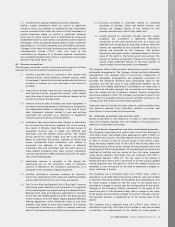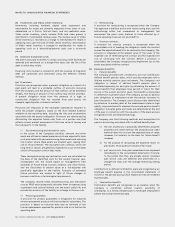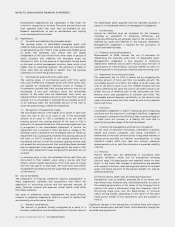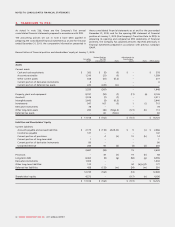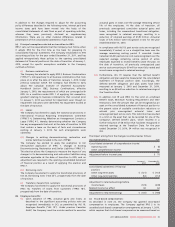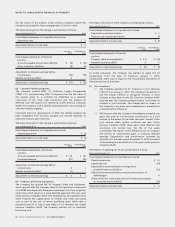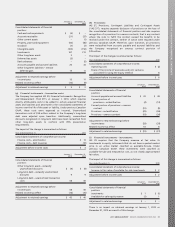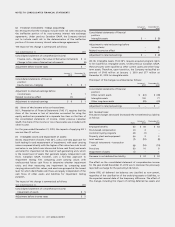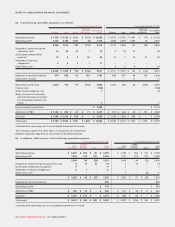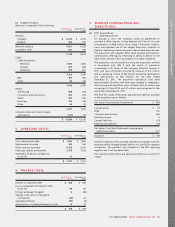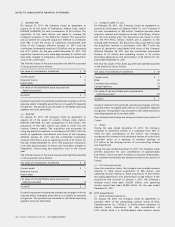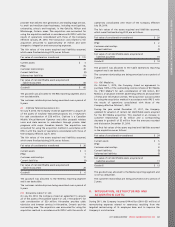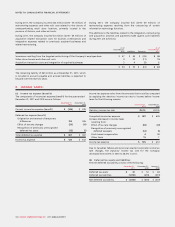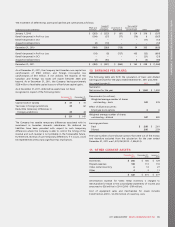Rogers 2011 Annual Report Download - page 99
Download and view the complete annual report
Please find page 99 of the 2011 Rogers annual report below. You can navigate through the pages in the report by either clicking on the pages listed below, or by using the keyword search tool below to find specific information within the annual report.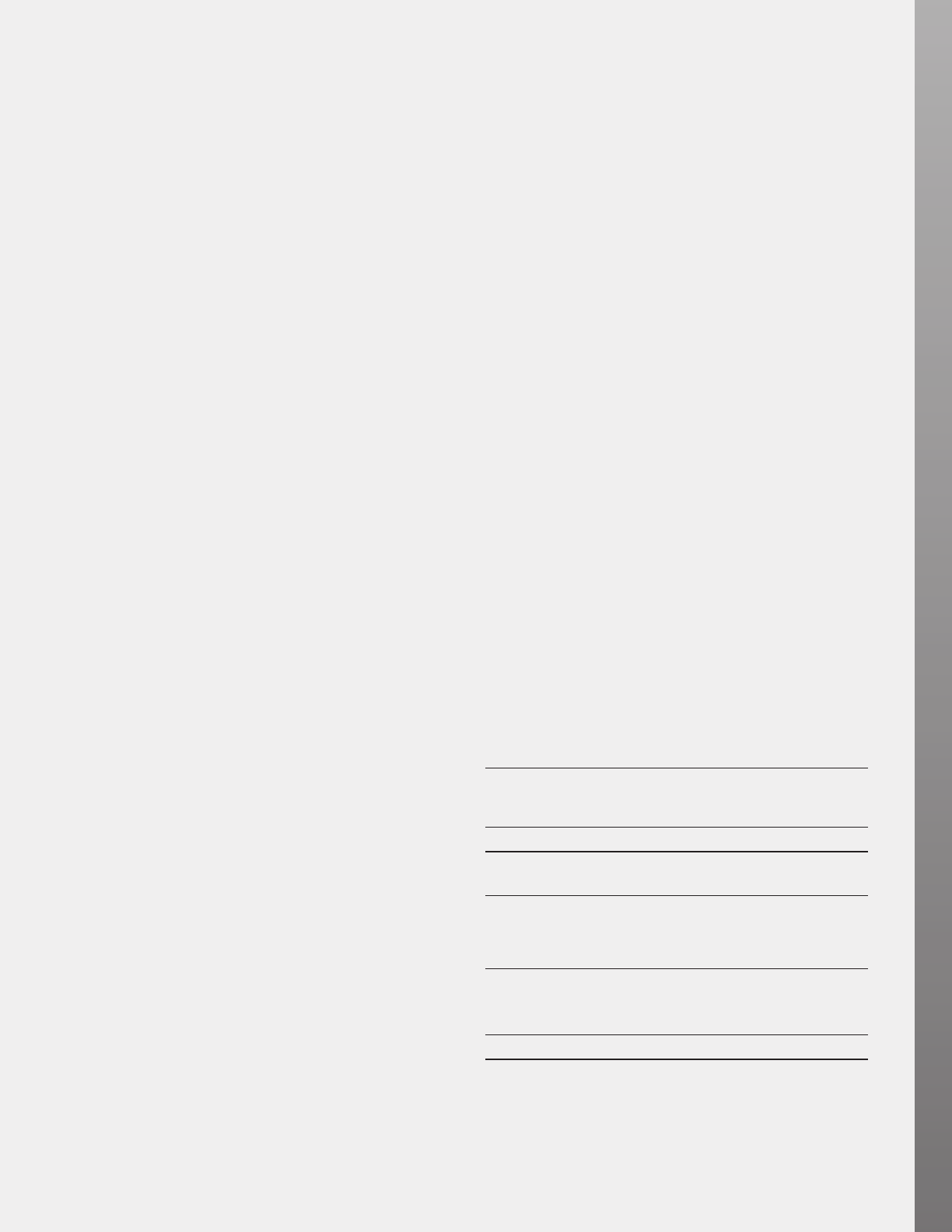
NOTES TO CONSOLIDATED FINANCIAL STATEMENTS
In addition to the changes required to adjust for the accounting
policy differences described in the following notes, interest paid and
income taxes paid have been moved into the body of the
consolidated statements of cash flows as part of operating activities,
whereas they were previously disclosed as supplementary
information. There are no other material differences related to
presentation of the consolidated statements of cash flows.
(a) Principal exemptions elected on transition to IFRS:
IFRS 1 sets out the requirements that the Company must follow when
it adopts IFRS for the first time as the basis for preparing its
consolidated financial statements. The Company established its IFRS
accounting policies for the year ended December 31, 2011, and has
applied retrospectively these policies to the opening consolidated
statement of financial position at the date of transition of January 1,
2010, except for specific exemptions available to the Company
outlined as follows:
(i) Business combinations:
The Company has elected to apply IFRS 3, Business Combinations
(“IFRS 3”), retrospectively to all business combinations that took
place on or after the date of transition, January 1, 2010. Under
previous Canadian GAAP, the Company had elected to early
adopt The Canadian Institute of Chartered Accountants’
Handbook Section 1582, Business Combinations, effective
January 1, 2010, the requirements of which are converged with
IFRS. As a condition under IFRS 1 of applying this exemption,
goodwill relating to business combinations that occurred prior
to January 1, 2010 was tested for impairment even though no
impairment indicators were identified. No impairment existed at
the date of transition.
(ii) Leases:
The Company has elected to apply the transitional provisions in
International Financial Reporting Interpretations Committee
(“IFRIC”) 4, Determining Whether an Arrangement Contains a
Lease (“IFRIC 4”), thereby determining whether the Company
has any arrangements that exist at the date of transition to IFRS
that contain a lease on the basis of facts and circumstances
existing at January 1, 2010. No such arrangements were
identified.
(iii) Changes in existing decommissioning, restoration and
similar liabilities included in the cost of PP&E:
The Company has elected to apply the exemption to full
retrospective application of IFRIC 1, Changes in Existing
Decommissioning, Restoration and Similar Liabilities (“IFRIC 1”).
This election allows the Company to measure the impact of any
changes to its decommissioning and restoration liabilities using
estimates applicable at the date of transition to IFRS, and no
adjustment was required to the opening consolidated statement
of financial position as a result of applying this election and
IFRIC 1.
(iv) Borrowing costs:
The Company has elected to apply the transitional provisions of
IAS 23, Borrowing Costs (“IAS 23”), prospectively from the date
of transition.
(v) Transfers of assets from customers:
The Company has elected to apply the transitional provisions of
IFRIC 18, Transfers of Assets from Customers (“IFRIC 18”),
prospectively from the date of transition.
(b) Employee benefits:
(i) Upon adoption of IFRS, actuarial gains and losses, as
described in the significant accounting policies note are
recognized immediately in OCI, as permitted by IAS 19,
Employee Benefits (“IAS 19”). Under previous Canadian
GAAP, the Company used the corridor method to amortize
actuarial gains or losses over the average remaining service
life of the employees. At the date of transition, all
previously unrecognized cumulative actuarial gains and
losses, including the unamortized transitional obligation,
were recognized in retained earnings, resulting in a
reduction of retained earnings of $149 million. Actuarial
losses of $76 million were recognized in OCI for the year
ended December 31, 2010.
(ii) In compliance with IAS 19, past service costs are recognized
immediately if vested, or on a straight-line basis over the
average remaining vesting period if unvested. Under
Canadian GAAP, past service costs were recognized over the
expected average remaining service period of active
employees expected to receive benefits under the plan. At
the date of transition, all previously unrecognized past
service costs amounting to $9 million were fully vested and
as such were recognized in retained earnings.
(iii) Furthermore, IAS 19 requires that the defined benefit
obligation and plan assets be measured at the consolidated
statement of financial position date. Accordingly, the
defined benefit obligation and plan assets have been
measured at January 1, 2010 and December 31, 2010,
resulting in an $8 million reduction to retained earnings at
the Transition Date.
(iv) In addition, IAS 19 and IFRIC 14, The Limit on a Defined
Benefit Asset, Minimum Funding Requirement and their
Interaction, limit the amount that can be recognized as an
asset on the consolidated statement of financial position to
the present value of available contribution reductions or
refunds plus unrecognized actuarial losses and
unrecognized past service costs. This restriction has resulted
in a limit on the asset that can be recorded for one of the
Company’s defined benefit plans, which resulted in a
further reduction of $8 million that has been recognized in
retained earnings at the Transition Date. For the year
ended December 31, 2010, $4 million was recognized in
OCI.
The impact arising from the changes is summarized as follows:
Year ended December 31, 2010
Consolidated statement of comprehensive income:
Operating costs $ (5)
Other comprehensive income 80
Adjustment before income taxes $ 75
January 1,
2010 December 31,
2010
Consolidated statements of financial
position:
Other long-term assets $ (121) $ (137)
Other long-term liabilities (53) (112)
Adjustment to retained earnings before
income taxes (174) (249)
Related income tax effect 44 64
Adjustment to retained earnings $ (130) $ (185)
(c) Stock-based compensation:
As described in note 22, the Company has granted stock-based
compensation to employees. The Company applied IFRS 2 to its
unsettled stock-based compensation arrangements at January 1, 2010,
which requires that stock-based compensation be measured based on
2011 ANNUAL REPORT ROGERS COMMUNICATIONS INC. 95


